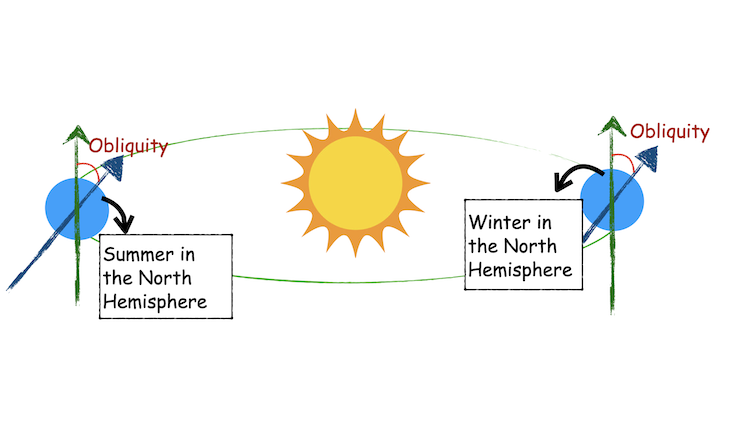Spring, summer, fall and winter – the seasons on Earth change every few months, around the same time every year. It’s easy to take this cycle for granted here on Earth, but not every planet has a regular change in seasons. So why does Earth have regular seasons when other planets don’t?
I’m an astrophysicist who studies the movement of planets and the causes of seasons. Throughout my research, I’ve found that Earth’s regular pattern of seasons is unique. The rotational axis that Earth spins on, along the North and South poles, isn’t quite aligned with the vertical axis perpendicular to Earth’s orbit around the Sun.
That slight tilt has big implications for everything from seasons to glacier cycles. The magnitude of that tilt can even determine whether a planet is habitable to life.
Seasons on Earth
When a planet has perfect alignment between the axis it orbits on and the rotational axis, the amount of sunlight it receives is fixed as it orbits around the Sun – assuming its orbital shape is a circle. Since seasons come from variations in how much sunlight reaches the planet’s surface, a planet that’s perfectly aligned wouldn’t have seasons. But Earth isn’t perfectly aligned on its axis.
This small misalignment, called an obliquity, is around 23 degrees from vertical for Earth. So, the Northern Hemisphere experiences more intense sunlight during the summer, when the Sun is positioned more directly above the Northern Hemisphere.
Then, as the Earth continues to orbit around the Sun, the amount of sunlight the Northern Hemisphere receives gradually decreases as the Northern Hemisphere tilts away from the Sun. This causes winter.

The obliquity marks the difference between the Earth’s spin axis (blue) and the vertical from orbit (green). The Northern Hemisphere experiences summer when the tilt lines it up directly with light from the Sun.
Gongjie Li
The planets spinning on their axes and orbiting around the Sun look kind of like spinning tops – they spin around and wobble because of gravitational pull from the Sun. As a top spins, you might notice that it doesn’t just stay perfectly upright and stationary. Instead, it may start to tilt or wobble slightly. This tilt is what astrophysicists call spin precession.
Because of these wobbles, Earth’s obliquity isn’t perfectly fixed. These small variations in tilt can have big effects on the Earth’s climate when combined with small changes to Earth’s orbit shape.
The wobbling tilt and any natural variations to the shape of Earth’s orbit can change the amount and distribution of sunlight reaching Earth. These small changes contribute to the planet’s larger temperature shifts over thousands to hundreds of thousands of years. This can, in turn, drive ice ages and periods of warmth.



